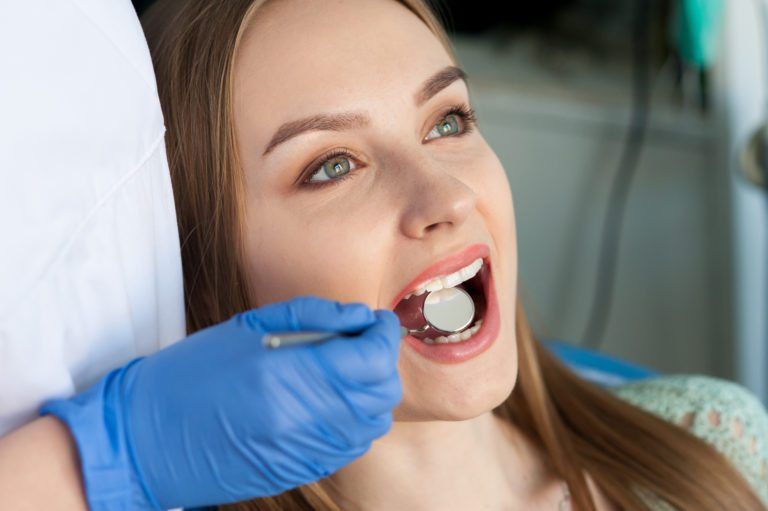Your First Visit

What should I expect at my exam and cleaning appointments?
Your initial visit will consist of a visible examination of the teeth and gums. Dental x-rays, or radiographs, will be taken to check for cavities between the teeth where the dentist cannot fully visualize with sight alone. Other types of x-rays may be taken to check for abscessed teeth, impacted teeth, TMJ problems, or other problems within the bone and jaws. Dental photographs will be taken to record your existing dentition and we will chart all existing restorations you may have. The hygienist will check your gums with a special instrument called a periodontal probe. This measures the gum pocket that surrounds each tooth. The depth of the pocket indicates whether the gum is healthy or if gum disease is present. If your gums are healthy with no signs of gum disease present, the hygienist may clean your teeth using special instruments to remove hardened plaque (tartar or calculus) from your teeth, followed by polishing. The dentist will examine the teeth, radiographs and photographs and will discuss any findings and potential treatment needs. Depending on the amount of time necessary for your cleaning this may be done at your exam appointment or it may need to be rescheduled for a separate appointment time with the hygienist. If gum disease is found to be present, the Doctor and Hygienist will review this with you in detail. (Please see “Scaling and Root Planning” below.)
Scaling and Root Planning
If the teeth and gums are found to be unhealthy, and have active gum disease, or periodontal disease, the hygienist and dentist will recommend a more advanced cleaning called scaling and root planning. This may also be referred to as a deep cleaning. If the pocket depths measured around your teeth are consistently over 3 mm, heavy tartar build up is detected below the gum lines on the roots of several teeth, bleeding gums is consistent throughout the mouth, or bone loss is visible on the radiographs, deep cleaning is needed.
You will most likely be rescheduled to have the deep cleaning done. This procedure requires additional time that may not be available in the schedule. Most insurance companies do not allow the deep cleaning to be completed in one visit. Most deep cleaning procedures are separated into two appointments. During the procedure, the gums may be given local anesthetic to help control pain. The hygienist uses special instruments to reach below the gums to effectively remove plaque, tartar build-up and diseased gum tissue. It is normal to experience some tenderness and discomfort following a deep cleaning. The dentist may prescribe pain killers to keep you comfortable following the treatment.
You will be rechecked for healing approximately six weeks following the scaling and root planing procedure. At that time, a light polishing may be done. Most patients who have undergone this procedure need to have regular cleanings every 3 to 4 months, instead of the traditional every 6 months, due to the complex nature of this condition.

Did you know…that Americans are less and less likely to visit the dentist as they age? Data from the Centers for Disease Control reports that only 57 percent of Americans over age 65 visited the dentist in 2010. That compares to about 61 percent adults under age 65 and about 79 percent of children ages 2 to 17. Nonetheless, it is important to visit the dentist for cleanings and exams regardless of how long has passed since your most recent dental appointment.
Frequently Asked Questions
Do I really need to have my teeth professionally cleaned?
Yes. Even if you brush and floss after every meal and before bed, bacteria-harboring plaque can accumulate in the tiniest crevices, grooves and pits. Overtime, the teeth will begin to decay in those areas, which may result in pain and partial or total tooth loss.
How often do I really need to have my teeth professionally cleaned?
Preventative care is a foundation of dentistry. The American Dental Association recommends visiting your dentist regularly – usually twice yearly – for full cleanings, examinations, and consultations for potential treatment. Professional dental cleanings help remove built-up plaque and tartar that is not removable using conventional brushing and flossing. Often, dentists are also capable of identifying potential problems that patients are not yet able to see or feel. When you maintain regular preventative dental appointments, you can stave off decay and gum disease, as well as identify the beginnings of oral health problems before they become severe.
What types of guidelines should I follow after my visit?
In between dental cleanings and consultations, be sure to maintain good oral habits at home. This includes daily flossing and brushing after meals. It’s also important to drink fluoridated water and use fluoridated toothpastes and mouth rinses.

